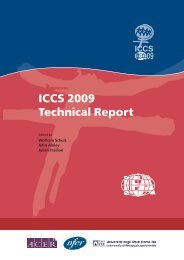Teacher Education and Development Study in Mathematics - IEA
Teacher Education and Development Study in Mathematics - IEA
Teacher Education and Development Study in Mathematics - IEA
You also want an ePaper? Increase the reach of your titles
YUMPU automatically turns print PDFs into web optimized ePapers that Google loves.
PART 2: HONG KONG SAR<br />
97<br />
Hong Kong SAR<br />
Composition of the teacher labor force<br />
The number of primary <strong>and</strong> secondary school teachers <strong>in</strong> Hong Kong <strong>in</strong>creased steadily<br />
dur<strong>in</strong>g the 1990s (Figure 29). Although the number of secondary school teachers is<br />
expected to cont<strong>in</strong>ue to rise, the decl<strong>in</strong>e <strong>in</strong> the number of children <strong>in</strong> the population<br />
began to affect the size of the k<strong>in</strong>dergarten <strong>and</strong> primary school labor force <strong>in</strong> the early<br />
2000s.<br />
Nearly all teachers <strong>in</strong> Hong Kong are university tra<strong>in</strong>ed. About three-quarters of<br />
primary school teachers <strong>and</strong> 92% of secondary school teachers have a Bachelor’s or<br />
higher degree. Of those who teach <strong>in</strong> government <strong>and</strong> aided schools, almost all have<br />
tra<strong>in</strong>ed as teachers. About 20% of private primary school teachers have not received<br />
pre-service education (Lai, 2006, Table 1). In total, about 70% of primary teachers have<br />
a university degree <strong>and</strong> are tra<strong>in</strong>ed. The correspond<strong>in</strong>g figure for secondary schools is<br />
88%. The subjects with the highest percentages of degree holders <strong>in</strong> primary schools<br />
are English (79%) <strong>and</strong> <strong>in</strong>formation <strong>and</strong> communication technology (ICT) (78%). In<br />
secondary schools, nearly all the teachers of economics, English, <strong>and</strong> senior secondary<br />
science subjects, such as biology, chemistry, <strong>and</strong> physics, have degrees. About 55% of<br />
teachers <strong>in</strong> the 1990s were females (Chung & Hung, 2001).<br />
Figure 29: Hong Kong SAR, Number of <strong>Teacher</strong>s, by Level of <strong>Education</strong>, 1994 to 2000<br />
30,000<br />
25,000<br />
Number of <strong>Teacher</strong>s<br />
20,000<br />
15,000<br />
10,000<br />
5,000<br />
0<br />
1994–1995 1995–1996 1996–1997 1997–1998 1998–1999 1999–2000 2000–2001<br />
Year<br />
K<strong>in</strong>dergarten<br />
Primary<br />
Secondary<br />
Vocational<br />
Accord<strong>in</strong>g to various studies, the quality of new entrants <strong>in</strong>to the teach<strong>in</strong>g profession<br />
<strong>in</strong> Hong Kong is not as high as the quality of entrants <strong>in</strong>to other professions. Lai, Chan,<br />
Ko, <strong>and</strong> So (2005) show that senior secondary school students consider that people who<br />
enter the teach<strong>in</strong>g profession do not have high academic st<strong>and</strong><strong>in</strong>g. This perception is<br />
borne out by the fact that the exam<strong>in</strong>ation grades of new students admitted <strong>in</strong>to teacher<br />
education programs are, on average, lower than those of students admitted to other<br />
university faculties (Lai, 2006).<br />
An important issue <strong>in</strong> Hong Kong is “out of field” teach<strong>in</strong>g. Accord<strong>in</strong>g to Lai (2006),<br />
many teachers <strong>in</strong> Hong Kong teach outside their subject field, <strong>and</strong> this is particularly<br />
true <strong>in</strong> subjects for which there is a short supply of qualified teachers.

















